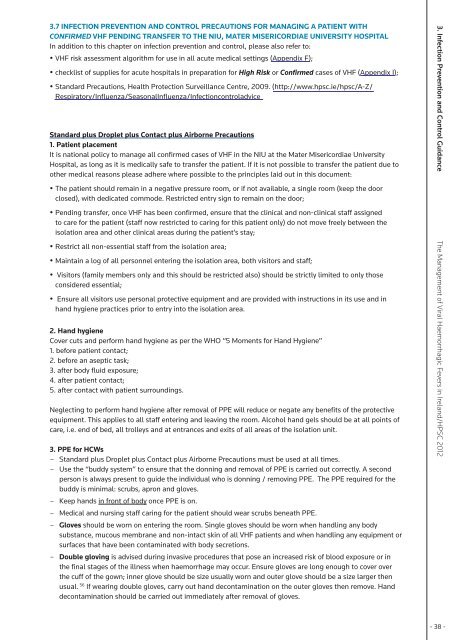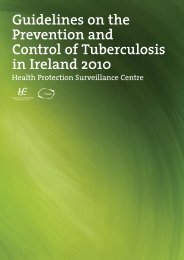The Management of Viral Haemorrhagic Fevers in Ireland - Health ...
The Management of Viral Haemorrhagic Fevers in Ireland - Health ...
The Management of Viral Haemorrhagic Fevers in Ireland - Health ...
Create successful ePaper yourself
Turn your PDF publications into a flip-book with our unique Google optimized e-Paper software.
3.7 Infection prevention and control precautions for manag<strong>in</strong>g a patient withconfirmed VHF pend<strong>in</strong>g transfer to the NIU, Mater Misericordiae University HospitalIn addition to this chapter on <strong>in</strong>fection prevention and control, please also refer to:• VHF risk assessment algorithm for use <strong>in</strong> all acute medical sett<strong>in</strong>gs (Appendix F);• checklist <strong>of</strong> supplies for acute hospitals <strong>in</strong> preparation for High Risk or Confirmed cases <strong>of</strong> VHF (Appendix I);• Standard Precautions, <strong>Health</strong> Protection Surveillance Centre, 2009. (http://www.hpsc.ie/hpsc/A-Z/Respiratory/Influenza/SeasonalInfluenza/InfectioncontroladviceStandard plus Droplet plus Contact plus Airborne Precautions1. Patient placementIt is national policy to manage all confirmed cases <strong>of</strong> VHF <strong>in</strong> the NIU at the Mater Misericordiae UniversityHospital, as long as it is medically safe to transfer the patient. If it is not possible to transfer the patient due toother medical reasons please adhere where possible to the pr<strong>in</strong>ciples laid out <strong>in</strong> this document:• <strong>The</strong> patient should rema<strong>in</strong> <strong>in</strong> a negative pressure room, or if not available, a s<strong>in</strong>gle room (keep the doorclosed), with dedicated commode. Restricted entry sign to rema<strong>in</strong> on the door;• Pend<strong>in</strong>g transfer, once VHF has been confirmed, ensure that the cl<strong>in</strong>ical and non-cl<strong>in</strong>ical staff assignedto care for the patient (staff now restricted to car<strong>in</strong>g for this patient only) do not move freely between theisolation area and other cl<strong>in</strong>ical areas dur<strong>in</strong>g the patient’s stay;• Restrict all non-essential staff from the isolation area;• Ma<strong>in</strong>ta<strong>in</strong> a log <strong>of</strong> all personnel enter<strong>in</strong>g the isolation area, both visitors and staff;• Visitors (family members only and this should be restricted also) should be strictly limited to only thoseconsidered essential;• Ensure all visitors use personal protective equipment and are provided with <strong>in</strong>structions <strong>in</strong> its use and <strong>in</strong>hand hygiene practices prior to entry <strong>in</strong>to the isolation area.2. Hand hygieneCover cuts and perform hand hygiene as per the WHO “5 Moments for Hand Hygiene”1. before patient contact;2. before an aseptic task;3. after body fluid exposure;4. after patient contact;5. after contact with patient surround<strong>in</strong>gs.Neglect<strong>in</strong>g to perform hand hygiene after removal <strong>of</strong> PPE will reduce or negate any benefits <strong>of</strong> the protectiveequipment. This applies to all staff enter<strong>in</strong>g and leav<strong>in</strong>g the room. Alcohol hand gels should be at all po<strong>in</strong>ts <strong>of</strong>care, i.e. end <strong>of</strong> bed, all trolleys and at entrances and exits <strong>of</strong> all areas <strong>of</strong> the isolation unit.3. PPE for HCWs- Standard plus Droplet plus Contact plus Airborne Precautions must be used at all times.- Use the “buddy system” to ensure that the donn<strong>in</strong>g and removal <strong>of</strong> PPE is carried out correctly. A secondperson is always present to guide the <strong>in</strong>dividual who is donn<strong>in</strong>g / remov<strong>in</strong>g PPE. <strong>The</strong> PPE required for thebuddy is m<strong>in</strong>imal: scrubs, apron and gloves.- Keep hands <strong>in</strong> front <strong>of</strong> body once PPE is on.- Medical and nurs<strong>in</strong>g staff car<strong>in</strong>g for the patient should wear scrubs beneath PPE.- Gloves should be worn on enter<strong>in</strong>g the room. S<strong>in</strong>gle gloves should be worn when handl<strong>in</strong>g any bodysubstance, mucous membrane and non-<strong>in</strong>tact sk<strong>in</strong> <strong>of</strong> all VHF patients and when handl<strong>in</strong>g any equipment orsurfaces that have been contam<strong>in</strong>ated with body secretions.- Double glov<strong>in</strong>g is advised dur<strong>in</strong>g <strong>in</strong>vasive procedures that pose an <strong>in</strong>creased risk <strong>of</strong> blood exposure or <strong>in</strong>the f<strong>in</strong>al stages <strong>of</strong> the illness when haemorrhage may occur. Ensure gloves are long enough to cover overthe cuff <strong>of</strong> the gown; <strong>in</strong>ner glove should be size usually worn and outer glove should be a size larger thenusual. 56 If wear<strong>in</strong>g double gloves, carry out hand decontam<strong>in</strong>ation on the outer gloves then remove. Handdecontam<strong>in</strong>ation should be carried out immediately after removal <strong>of</strong> gloves.3. Infection Prevention and Control Guidance <strong>The</strong> <strong>Management</strong> <strong>of</strong> <strong>Viral</strong> <strong>Haemorrhagic</strong> <strong>Fevers</strong> <strong>in</strong> <strong>Ireland</strong>/HPSC 2012- 38 -
















